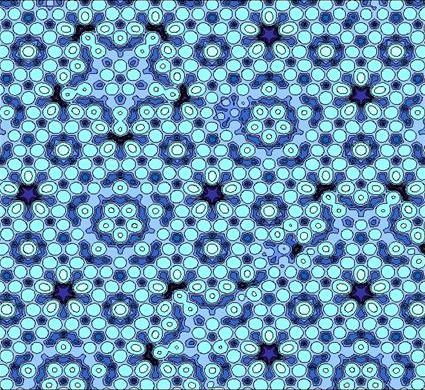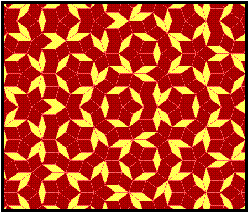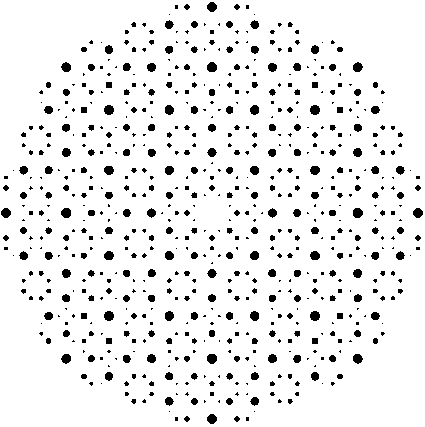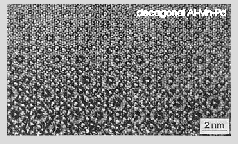
In classical crystallography a crystal is defined as a threedimensional periodic arrangement of atoms with translational periodicity along its three principal axes. Thus it is possible to obtain an infinitely extended crystal structure by aligning building blocks called unit-cells until the space is filled up. Normal crystal structures can be described by one of the 230 space groups, which describe the rotational and translational symmetry elements present in the structure. Diffraction patterns of these normal crystals therefore show crystallographic point symmetries (belonging to one of the 11 Laue-groups). In 1984, however, Shechtman, Blech, Gratias & Cahn published a paper which marked the discovery of quasicrystals. They showed electron diffraction patterns of an Al-Mn alloy with sharp reflections and 10-fold symmetry. The whole set of diffraction patterns revealed an icosahedral symmetry of the reciprocal space. Since then many stable and meta-stable quasicrystals were found. These are often binary or ternary intermetallic alloys with aluminium as one of the constituents. The icosahedral quasicrystals form one group and the polygonal quasicrystals another (8,10,12-fold symmetry). We can state that quasicrystals are materials with perfect long-range order, but with no three-dimensional translational periodicity. The former is manifested in the occurrence of sharp diffraction spots and the latter in the presence of a non-crystallographic rotational symmetry.

quasicrystal, is a structure that is ordered but not periodic. A quasicrystalline pattern can continuously fill all available space, but it lacks translational symmetry. While crystals, according to the classical crystallographic restriction theorem, can possess only two, three, four, and six-fold rotational symmetries, the Bragg diffraction pattern of quasicrystals shows sharp peaks with other symmetry orders, for instance five-fold
quasiperiodic in two dimensions (polygonal or dihedral quasicrystals)
There is one periodic direction perpendicular to the quasiperodic layers.
- octagonal quasicrystals with local 8-fold symmetry [primitive & body-centered lattices]
- decagonal quasicrystals with local 10-fold symmetry [primitive lattice]
- dodecagonal quasicrystals with local 12-fold symmetry [primitive lattice]
quasiperiodic in three dimensions, no periodic direction
- icosahedral quasicrystals (axes:12x5-fold, 20x3-fold, 30x2-fold) [primitive, body-centered & face-centered lattices]

Regarding thermal stability, three types of quasicrystals are distinguished:
§ Stable quasicrystals grown by slow cooling or casting with subsequent annealing,
§ Metastable quasicrystals prepared by melt spinning, and
§ Metastable quasicrystals formed by the crystallization of the amorphous phase.
Except for the Al–Li–Cu system, all the stable quasicrystals are almost free of defects and disorder, as evidenced by x-ray and electron diffraction revealing peak widths as sharp as those of perfect crystals such as Si. Diffraction patterns exhibit fivefold, threefold, and twofold symmetries, and reflections are arranged quasiperiodically in three dimensions.
The origin of the stabilization mechanism is different for the stable and metastable quasicrystals. Nevertheless, there is a common feature observed in most quasicrystal-forming liquid alloys or their undercooled liquids: a local icosahedral order. The icosahedral order is in equilibrium in the liquid state for the stable quasicrystals, whereas the icosahedral order prevails in the undercooled liquid statefor the metastable quasicrystals.
History...
Before quasicrystals were discovered in 1984 the british mathmatician Roger Penrose devised a way to cover a plane in a nonperiodic fashion using two different types of tiles. An example can be seen on the left. The tiles (rhombii) are arranged in a way that they obey certain matching rules. An equivalent tiling can be obtained for a 3D-arrangement. This is called a 3D-Penrose Tiling, which is made up of rhombohedrons instead of the rhombii. Such 2D and 3D-tilings have several important properties, such as the selfsimilarity, which means that any part of the tiling occurs again within a predictable area (or volume). After the discovery of quasicrystals in 1984 a close resemblance was noted between the icosahedral quasicrystal and the 3D-Penrose pattern. By putting atoms at the vertices of a 3D-Penrose pattern one can obtain a Fourier Transform which explains very well the diffraction patterns of the found Al-Mn quasicrystal. In a similar way one can use 2D-Penrose Tilings (left) to approximate a decagonal quasicrystal, which in a simple case consists of two layers with local 5-fold symmetry, which are rotated by 18 degrees so that the projection along the rotation axis gives a 10-fold symmetry. As stated above it is also possible to derive the vertices of such tilings using the nD-space approach (n>3). In this case we can obtain such a tiling by a projection of a nD periodic lattice (eg. hypercubic lattice).
In short, we can regard quasiperiodic tilings as frameworks that give quasicrystal structures when filled up with atoms in an appropriate way.

Diffreaction Pattern




Materials Science of Quasicrystals
Since the original discovery of Dan Shechtman, hundreds of quasicrystals have been reported and confirmed. Undoubtedly, the quasicrystals are no longer a unique form of solid; they exist universally in many metallic alloys and some polymers. Quasicrystals are found most often in aluminium alloys (Al-Li-Cu, Al-Mn-Si, Al-Ni-Co, Al-Pd-Mn, Al-Cu-Fe, Al-Cu-V, etc.), but numerous other compositions are also known (Cd-Yb, Ti-Zr-Ni, Zn-Mg-Ho, Zn-Mg-Sc, In-Ag-Yb, Pd-U-Si, etc.)
Expermental Techniques
| selected area electron diffraction (SAED) | obtain reciprocal space information (symmetry, point group) |
| convergent beam electron diffraction (CBED) | determination of the point group & space group |
| high resolution transmission electron microscopy (HRTEM) | real structure information (below decagonal Al-Mn-Pd)  |
| X-ray diffraction techniques | Film methods: Laue, Precession, Debye-Sherrer Quantitative measurement: Powder diffractometer, Four-circle diffractometer |
| neutron diffraction | obtain partial structure factors to assist structure refinement |
There are basically two different methods for solving the structure of quasicrystals. The first one is a 3D method, where information obtained from HRTEM images and known approximant structures is combined to obtain a realistic structure model.
The second one is the so-called nD structure analysis (n>3), where the structure is modeled in terms of the contents of the nD unit cells, i.e. the occupation domains. In contrast to the 3D method this is a quantitative analysis, which allows to calculate diffraction patterns and to refine a variety of parameters by the least-squares method. It therefore allows us to use all mathematical tools that have been applied in the analysis of conventional crystals, however, extended to the nD space. This technique may include the steps listed below, assuming the application of the nD-maximum entropy method as used by YAMAMOTO et al.
Step 1 - information on the three-dimensional structure
HRTEM images should be taken to obtain as much structural information as possible on the actual three-dimensional structure. For polygonal quasicrystals this means in particular the clarification of the cluster arrangement (in case there are basic clusters that form the whole structure). For icosahedral quasicrystals it is not possible as easily to determine cluster positions, since the high-resolution image shows only the projected structure along some direction. Information on the third spatial coordinate is therefore lost and possibly present clusters cannot accurately be associated with x, y and z-coordinates. The HRTEM images have a limited resolution in direct space so that the actual atom arrangement (distinction between atom species) within one cluster cannot be determined. Therefore an approximant structure can be helpful in giving a possible atom arrangement for some clusters, which can then be introduced into the structure model. An X-ray structure analysis for the approximant is in most cases straightforward and might even have been done before, so that already published data might be readily available.
This step 1 corresponds to the above mentioned first structure solution procedure.
Step 2 - location of occupation domains
The basis for the quasicrystal structure analysis is a single (quasi)crystal X-ray data set, usually taken on a four-circle diffractometer. (In future, however, imaging plate techniques might gain importance, since they allow rapid simultaneous measurements of many reflections including diffuse scattering intensities) The first thing to do with the measured X-ray data is to determine the exact location of the occupation domains. This can be done by using the nD Patterson method, which does not require any structure model, since only the square amplitudes of the structure factors go into the calculation.
Step 3 - nD starting model
The information from the first thwo steps is then combined to obtain a first rough nD structure model. This consists of a number of occupation domains at their determined locations. The occupation domains have to be constructed in such a way that by applying the section method the observed cluster arrangement is obtained, as well as the atomic decoration of the clusters as suggested by a known approximant structure.
Step 4 - MEM (maximum entropy method)
The starting model will then be refined, in order to obtain the phases of some strongest reflections, which is necessary for the MEM calculations. After performing the MEM calculations internal space MEM maps have to be plotted. These MEM maps provide information on the presence of possibly new (additional) occupation domains. Furthermore they show in more detail the size and shape of the occupation domains and the peak heights give hints on the distribution of transition metal atoms.
Step 5 - structure model modification
The information obtained from the MEM maps is then used for the modification of the nD structure model (i.e. the occupation domains). If necessary newly found ODs have to be constructed. The most difficult part is the distribution of atom species among the occupation domains. This is despite the findings in the MEM maps a trial and error procedure, due to the frequently occurring mixed occupancies. Key indicators for a structure model to be reasonable is the calculated point density and the calculated chemical composition.
Step 6 - refinement
The constructed structure model is then refined by means of the least-squares method. The necessity of further model modifications might arise so that steps 5 and 6 have to be repeated until a satisfactory structure solution is found. The refinement should include all necessary positional, occupational and thermal parameters.
Step 7 - structure plots
After obtaining the final structure model, several structure projections need to be drawn in order to elucidate the resulting structure. Since the section method provides all atom positions in x, y and z coordinates, individual clusters can be cut out (using suitable software, such as XRSV) and plotted separately, in order to show more clearly the local structure in the clusters.
| octagonal QC: V-Ni-Si | decagonal QC: Al-TM (TM=Ir,Pd,Pt,Os,Ru,Rh,Mn,Fe,Co,Ni,Cr) |
| dodecagonal QC: Cr-Ni | icosahedral QC: Al-Mn |

